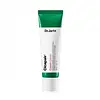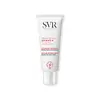What's inside
What's inside
 Key Ingredients
Key Ingredients

 Benefits
Benefits

 Concerns
Concerns

 Ingredients Side-by-side
Ingredients Side-by-side

Water
Skin ConditioningPropanediol
SolventCentella Asiatica Leaf Water
Skin ConditioningButylene Glycol
HumectantCaprylic/Capric Triglyceride
MaskingPanthenol
Skin ConditioningDiisostearyl Malate
EmollientPolyglyceryl-3 Methylglucose Distearate
EmulsifyingButyrospermum Parkii Butter
Skin ConditioningGlyceryl Stearate
EmollientMacadamia Ternifolia Seed Oil
EmollientCetearyl Alcohol
EmollientHydrogenated Poly(C6-14 Olefin)
EmollientHydrogenated Polydecene
EmollientHydrogenated Polyisobutene
Emollient1,2-Hexanediol
Skin ConditioningPEG-8
HumectantPEG-100 Stearate
Polyacrylate-13
Palmitic Acid
EmollientTocopheryl Acetate
AntioxidantBeeswax
Emulsion StabilisingGlycerin
HumectantStearic Acid
CleansingPhenoxyethanol
PreservativePolyisobutene
Asiaticoside
AntioxidantCarbomer
Emulsion StabilisingMadecassic Acid
Skin ConditioningAsiatic Acid
Skin ConditioningSpirulina Platensis Powder
Skin ProtectingAlcohol
AntimicrobialPolysorbate 20
EmulsifyingEthylhexylglycerin
Skin ConditioningLavandula Angustifolia Oil
MaskingSorbitan Isostearate
EmulsifyingAdenosine
Skin ConditioningCeramide AP
Skin ConditioningCitrus Grandis Peel Oil
MaskingHydrogenated Lecithin
EmulsifyingDisodium EDTA
Rosmarinus Officinalis Leaf Oil
MaskingAnthemis Nobilis Flower Oil
MaskingSodium Hyaluronate
HumectantCentella Asiatica Extract
CleansingTheobroma Cacao Extract
Skin ConditioningDextrin
AbsorbentHouttuynia Cordata Extract
Skin ConditioningAniba Rosaeodora Wood Oil
AstringentCentella Asiatica Meristem Cell Culture
AntioxidantMadecassoside
AntioxidantCitric Acid
BufferingAchillea Millefolium Extract
CleansingArtemisia Absinthium Extract
Skin ConditioningArnica Montana Flower Extract
MaskingGentiana Lutea Root Extract
Skin ConditioningSucrose Laurate
EmollientSodium Glycerophosphate
Selaginella Lepidophylla Extract
EmollientPotassium Magnesium Aspartate
BufferingLysolecithin
EmulsifyingMagnesium Gluconate
Skin ConditioningCalcium Gluconate
HumectantPotassium Sorbate
PreservativeSodium Ascorbyl Phosphate
AntioxidantSodium Benzoate
MaskingXanthan Gum
EmulsifyingWater, Propanediol, Centella Asiatica Leaf Water, Butylene Glycol, Caprylic/Capric Triglyceride, Panthenol, Diisostearyl Malate, Polyglyceryl-3 Methylglucose Distearate, Butyrospermum Parkii Butter, Glyceryl Stearate, Macadamia Ternifolia Seed Oil, Cetearyl Alcohol, Hydrogenated Poly(C6-14 Olefin), Hydrogenated Polydecene, Hydrogenated Polyisobutene, 1,2-Hexanediol, PEG-8, PEG-100 Stearate, Polyacrylate-13, Palmitic Acid, Tocopheryl Acetate, Beeswax, Glycerin, Stearic Acid, Phenoxyethanol, Polyisobutene, Asiaticoside, Carbomer, Madecassic Acid, Asiatic Acid, Spirulina Platensis Powder, Alcohol, Polysorbate 20, Ethylhexylglycerin, Lavandula Angustifolia Oil, Sorbitan Isostearate, Adenosine, Ceramide AP, Citrus Grandis Peel Oil, Hydrogenated Lecithin, Disodium EDTA, Rosmarinus Officinalis Leaf Oil, Anthemis Nobilis Flower Oil, Sodium Hyaluronate, Centella Asiatica Extract, Theobroma Cacao Extract, Dextrin, Houttuynia Cordata Extract, Aniba Rosaeodora Wood Oil, Centella Asiatica Meristem Cell Culture, Madecassoside, Citric Acid, Achillea Millefolium Extract, Artemisia Absinthium Extract, Arnica Montana Flower Extract, Gentiana Lutea Root Extract, Sucrose Laurate, Sodium Glycerophosphate, Selaginella Lepidophylla Extract, Potassium Magnesium Aspartate, Lysolecithin, Magnesium Gluconate, Calcium Gluconate, Potassium Sorbate, Sodium Ascorbyl Phosphate, Sodium Benzoate, Xanthan Gum
Water
Skin ConditioningDicaprylyl Carbonate
EmollientDiethylamino Hydroxybenzoyl Hexyl Benzoate
UV FilterDiethylhexyl Butamido Triazone
UV AbsorberDiisopropyl Adipate
EmollientSilica
AbrasiveCetearyl Alcohol
EmollientBis-Ethylhexyloxyphenol Methoxyphenyl Triazine
Skin ConditioningCeteareth-20
CleansingEthylhexyl Triazone
UV AbsorberDimethicone
EmollientNiacinamide
SmoothingPolymethyl Methacrylate
Pentylene Glycol
Skin ConditioningPolyester-7
Skin ConditioningAminomethyl Propanol
BufferingBeta-Carotene
Skin ConditioningBeta-Sitosterol
Emulsion StabilisingCetearyl Dimethicone Crosspolymer
Daucus Carota Sativa Root Extract
Skin ConditioningGlycine Soja Oil
EmollientHydrogenated Phosphatidylcholine
EmulsifyingLecithin
EmollientLepidium Sativum Sprout Extract
Skin ConditioningSqualene
EmollientAlpha-Glucan Oligosaccharide
CleansingCaffeyl Glucoside
AntioxidantDisodium Acetyl Glucosamine Phosphate
Skin ConditioningGlucose
HumectantGlycerin
HumectantPhytic Acid
Rhamnose
HumectantTocopherol
AntioxidantTocopheryl Acetate
Antioxidant1,2-Hexanediol
Skin ConditioningCaprylic/Capric Triglyceride
MaskingCaprylyl Glycol
EmollientCitric Acid
BufferingGlucuronic Acid
BufferingHydroxyethyl Acrylate/Sodium Acryloyldimethyl Taurate Copolymer
Emulsion StabilisingLysolecithin
EmulsifyingNeopentyl Glycol Diheptanoate
EmollientPolysorbate 60
EmulsifyingPropanediol
SolventSodium Laureth Sulfate
CleansingSorbitan Isostearate
EmulsifyingXanthan Gum
EmulsifyingPotassium Sorbate
PreservativeSodium Benzoate
MaskingWater, Dicaprylyl Carbonate, Diethylamino Hydroxybenzoyl Hexyl Benzoate, Diethylhexyl Butamido Triazone, Diisopropyl Adipate, Silica, Cetearyl Alcohol, Bis-Ethylhexyloxyphenol Methoxyphenyl Triazine, Ceteareth-20, Ethylhexyl Triazone, Dimethicone, Niacinamide, Polymethyl Methacrylate, Pentylene Glycol, Polyester-7, Aminomethyl Propanol, Beta-Carotene, Beta-Sitosterol, Cetearyl Dimethicone Crosspolymer, Daucus Carota Sativa Root Extract, Glycine Soja Oil, Hydrogenated Phosphatidylcholine, Lecithin, Lepidium Sativum Sprout Extract, Squalene, Alpha-Glucan Oligosaccharide, Caffeyl Glucoside, Disodium Acetyl Glucosamine Phosphate, Glucose, Glycerin, Phytic Acid, Rhamnose, Tocopherol, Tocopheryl Acetate, 1,2-Hexanediol, Caprylic/Capric Triglyceride, Caprylyl Glycol, Citric Acid, Glucuronic Acid, Hydroxyethyl Acrylate/Sodium Acryloyldimethyl Taurate Copolymer, Lysolecithin, Neopentyl Glycol Diheptanoate, Polysorbate 60, Propanediol, Sodium Laureth Sulfate, Sorbitan Isostearate, Xanthan Gum, Potassium Sorbate, Sodium Benzoate
Ingredients Explained
These ingredients are found in both products.
Ingredients higher up in an ingredient list are typically present in a larger amount.
1,2-Hexanediol is a synthetic liquid and another multi-functional powerhouse.
It is a:
- Humectant, drawing moisture into the skin
- Emollient, helping to soften skin
- Solvent, dispersing and stabilizing formulas
- Preservative booster, enhancing the antimicrobial activity of other preservatives
This ingredient is an emollient, solvent, and texture enhancer. It is considered a skin-softener by helping the skin prevent moisture loss.
It helps thicken a product's formula and makes it easier to spread by dissolving clumping compounds.
Caprylic Triglyceride is made by combining glycerin with coconut oil, forming a clear liquid.
While there is an assumption Caprylic Triglyceride can clog pores due to it being derived from coconut oil, there is no research supporting this.
Learn more about Caprylic/Capric TriglycerideCetearyl alcohol is a mixture of two fatty alcohols: cetyl alcohol and stearyl alcohol. It is mainly used as an emulsifier. Emulsifiers help prevent the separation of oils and products. Due to its composition, it can also be used to thicken a product or help create foam.
Cetearyl alcohol is an emollient. Emollients help soothe and hydrate the skin by trapping moisture.
Studies show Cetearyl alcohol is non-toxic and non-irritating. The FDA allows products labeled "alcohol-free" to have fatty alcohols.
This ingredient is usually derived from plant oils such as palm, vegetable, or coconut oils. There is debate on whether this ingredient will cause acne.
Due to the fatty acid base, this ingredient may not be Malassezia folliculitis safe.
Learn more about Cetearyl AlcoholCitric Acid is an alpha hydroxy acid (AHA) naturally found in citrus fruits like oranges, lemons, and limes.
Like other AHAs, citric acid can exfoliate skin by breaking down the bonds that hold dead skin cells together. This helps reveal smoother and brighter skin underneath.
However, this exfoliating effect only happens at high concentrations (20%) which can be hard to find in cosmetic products.
Due to this, citric acid is usually included in small amounts as a pH adjuster. This helps keep products slightly more acidic and compatible with skin's natural pH.
In skincare formulas, citric acid can:
While it can provide some skin benefits, research shows lactic acid and glycolic acid are generally more effective and less irritating exfoliants.
Most citric acid used in skincare today is made by fermenting sugars (usually from molasses). This synthetic version is identical to the natural citrus form but easier to stabilize and use in formulations.
Read more about some other popular AHA's here:
Learn more about Citric AcidGlycerin is already naturally found in your skin. It helps moisturize and protect your skin.
A study from 2016 found glycerin to be more effective as a humectant than AHAs and hyaluronic acid.
As a humectant, it helps the skin stay hydrated by pulling moisture to your skin. The low molecular weight of glycerin allows it to pull moisture into the deeper layers of your skin.
Hydrated skin improves your skin barrier; Your skin barrier helps protect against irritants and bacteria.
Glycerin has also been found to have antimicrobial and antiviral properties. Due to these properties, glycerin is often used in wound and burn treatments.
In cosmetics, glycerin is usually derived from plants such as soybean or palm. However, it can also be sourced from animals, such as tallow or animal fat.
This ingredient is organic, colorless, odorless, and non-toxic.
Glycerin is the name for this ingredient in American English. British English uses Glycerol/Glycerine.
Learn more about GlycerinWe don't have a description for Lysolecithin yet.
Potassium Sorbate is a preservative used to prevent yeast and mold in products. It is commonly found in both cosmetic and food products.
This ingredient comes from potassium salt derived from sorbic acid. Sorbic acid is a natural antibiotic and effective against fungus.
Both potassium sorbate and sorbic acid can be found in baked goods, cheeses, dried meats, dried fruit, ice cream, pickles, wine, yogurt, and more.
You'll often find this ingredient used with other preservatives.
Learn more about Potassium SorbatePropanediol is an all-star ingredient. It softens, hydrates, and smooths the skin.
It’s often used to:
Propanediol is not likely to cause sensitivity and considered safe to use. It is derived from corn or petroleum with a clear color and no scent.
Learn more about PropanediolSodium Benzoate is a preservative. It's used in both cosmetic and food products to inhibit the growth of mold and bacteria. It is typically produced synthetically.
Both the US FDA and EU Health Committee have approved the use of sodium benzoate. In the US, levels of 0.1% (of the total product) are allowed.
Sodium benzoate works as a preservative by inhibiting the growth of bacteria inside of cells. It prevents the cell from fermenting a type of sugar using an enzyme called phosphofructokinase.
It is the salt of benzoic acid. Foods containing sodium benzoate include soda, salad dressings, condiments, fruit juices, wines, and snack foods.
Studies for using ascorbic acid and sodium benzoate in cosmetics are lacking, especially in skincare routines with multiple steps.
We always recommend speaking with a professional, such as a dermatologist, if you have any concerns.
Learn more about Sodium BenzoateSorbitan Isostearate is an emulsifer and cleaning agent. It is created from isostearic acid and sorbitol.
As an emulsifier, Sorbitan Isostearate prevents oils and water from separating.
Due to its isostearic acid base, it may not be safe for Malassezia or fungal acne.
Learn more about Sorbitan IsostearateTocopheryl Acetate is AKA Vitamin E. It is an antioxidant and protects your skin from free radicals. Free radicals damage the skin by breaking down collagen.
One study found using Tocopheryl Acetate with Vitamin C decreased the number of sunburned cells.
Tocopheryl Acetate is commonly found in both skincare and dietary supplements.
Learn more about Tocopheryl AcetateWater. It's the most common cosmetic ingredient of all. You'll usually see it at the top of ingredient lists, meaning that it makes up the largest part of the product.
So why is it so popular? Water most often acts as a solvent - this means that it helps dissolve other ingredients into the formulation.
You'll also recognize water as that liquid we all need to stay alive. If you see this, drink a glass of water. Stay hydrated!
Learn more about WaterXanthan gum is used as a stabilizer and thickener within cosmetic products. It helps give products a sticky, thick feeling - preventing them from being too runny.
On the technical side of things, xanthan gum is a polysaccharide - a combination consisting of multiple sugar molecules bonded together.
Xanthan gum is a pretty common and great ingredient. It is a natural, non-toxic, non-irritating ingredient that is also commonly used in food products.
Learn more about Xanthan Gum